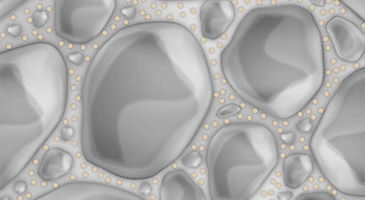Aggregates
Aggregates are sand, gravel, etc. They do not participate to the chemical reactions inside concrete, but their role is however very important, as they are the “skeleton” of concrete. They must fulfill several requirements, basically in terms of mineralogical quality, grain size distribution and absence of impurities that are potentially harmful for hardened concrete. An accurate determination of their moisture content is basic as well, for the production of a controlled quality concrete.
Aggregates
Aggregates are usually classified on the basis of their size:
- Coarse aggregate (>4 mm) (e.g. gravel)
- Fine aggregate (<4 mm) (e.g. sand)
- Filler (<0,063 mm)
Other classifications can be added on the basis of their mineralogical composition:
- Calcareous
- Quartziticor on the basis of their origin:
Natural (usually with smooth shape)
Crushed (usually with angular shape)
Grain Size Distribution
Only on size of aggregates is not suitable for concrete manufacturing. If only coarse aggregate is used, the voids are extremely large: a very big amount of cement paste will be necessary to fill it and the final concrete will be expensive and characterised by several problems (shrinkage, heating). If only fine aggregate is used, the total surface to be bound with cement paste will be extremely large and again a very big amount of cement will be necessary.
Hence, a good aggregate grain size distribution is very important and reference curves are used for this purpose, such as Fuller curve, Bolomey curve, cubic curve, etc..
The correct procedure requires:- the sieving of the available aggregates the use of the graphical method for determining the percentage of the various aggregates to be used for the concrete manufacturing.
Other Requirements
The maximum size of aggregate is a very important parameter and must be selected on the basis of the sizes of the concrete structural element to build. Aggregate maximum size cannot be too large, because fluid concrete must easily pass between steel reinforcement and between reinforcement and formworks, in order to properly fill the formworks and not to leave voids.
Aggregates Moisture
Aggregates are usually stocked outside, hence temperature, rain, air relative humidity, sun greatly influence their moisture content, which is an important parameter in concrete technology. Aggregate can be in different conditions, as shown in Figure 10 When aggregate are dry or humid, they subtract water to the fresh concrete mixture, while when they are wet they supply an additional amount of water to the mixture.
Only in saturated surface dry conditions the aggregate do not alter the concrete proportions and in fact, in the concrete formulation, aggregate are always considered in saturated surface dry condition. Of course, aggregate are usually not in this condition, thus the water introduced in the mixture must be corrected accordingly (increased when aggregate is dry, decreased when aggregate is wet).
Even if the moisture percentage in aggregate is not very high (1-10% percent in most of cases), the total amount of water added to or subtracted from the mixture is very significant, due to the large quantity of aggregate per cubic meter.
Recycled Aggregates
Concrete and demolition wastes (C&D waste) are becoming popular as new sustainable source of recycled aggregates, however, their use must be carefully considered. For structural concrete only the use of concrete waste is recommended and allowed in EU. Recycled aggregates must fulfill all the requirements set for natural aggregates (e.g.: grain size distribution, chloride and sulphate content, alkali reactivity, etc.) and special attention must be addressed to their porosity. Indeed, concrete aggregates are usually covered on their surface by adherent mortar thus resulting more porous than natural aggregates.
Such porosity increases water absorption in the concrete mix, causing a reduction of the effective water/cement ratio in the mix design and, consequently, a lowering of workability.






